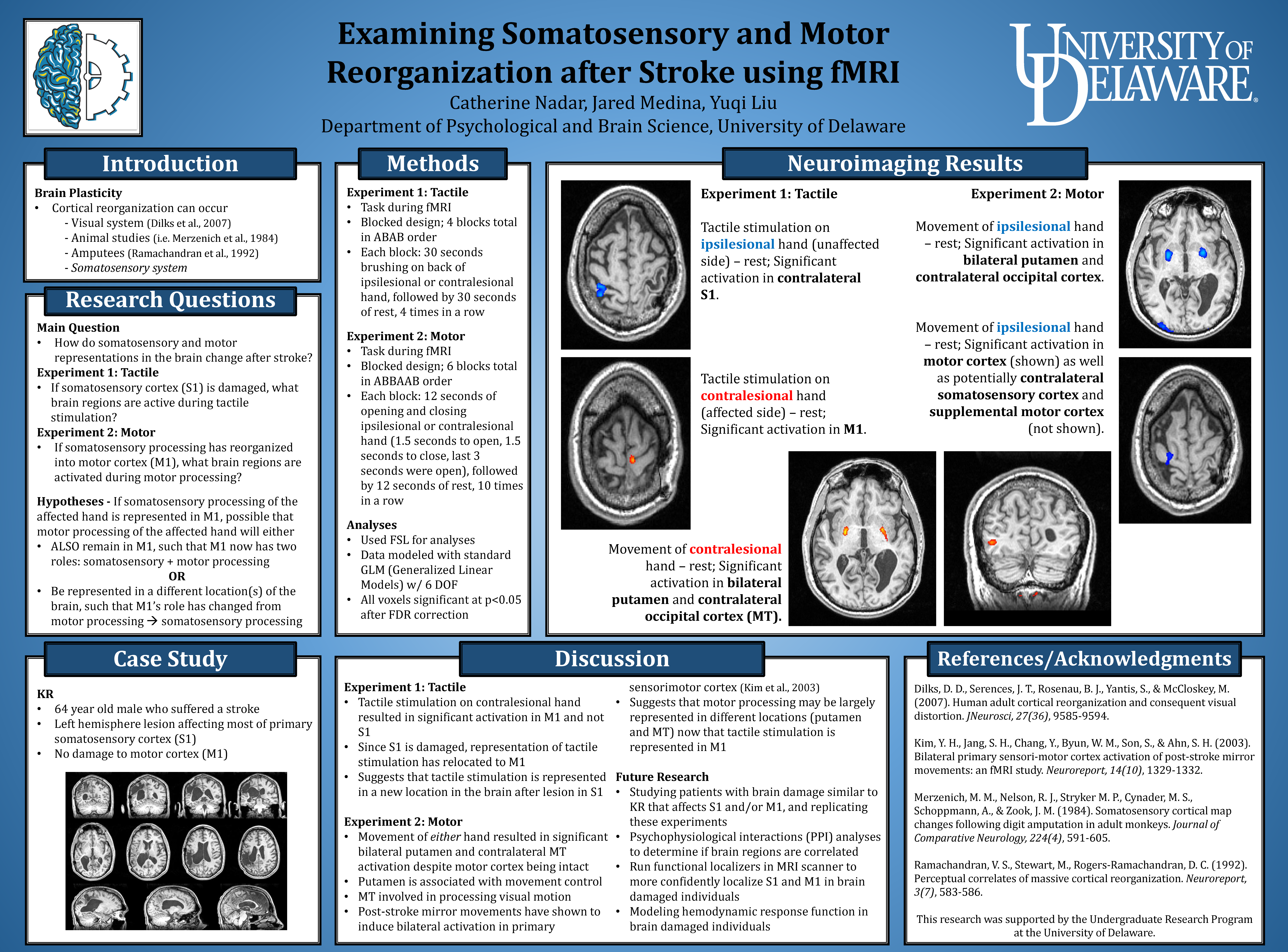Examining somatosensory and motor plasticity after stroke using fMRI
Background & Questions
We wanted to know more about brain plasticity (the brain’s ability to reorganize itself) after stroke. Specifically, within the somatosensory (brain area for processing sensory information from the body) and motor cortex (brain area for directing movement of the body).
Two main questions to address:
- If somatosensory cortex (S1) is damaged, what brain regions are active during tactile stimulation?
- If somatosensory processing has reorganized into the motor cortex (M1), what brain regions are activated during motor processing?

Method
To answer these questions, we conducted a two-part experiment using fMRI scanning in a patient (n=1) case study. The first experiment addressed Question 1, and the second experiment addressed Question 2.
Prior to this project, we conducted neuropsychological experiments to screen for neurological damage and resulting sensory/motor deficits.
Important Findings
We found that, despite this patient’s brain damage to somatosensory cortex, brushing the patient’s hand activated motor cortex in the brain. And although this patient’s brain damage did not extend to motor cortex, movement of the hand resulted in activation in other regions of the brain.
Future research should seek out additional patients with similar patterns of brain damage to see if similar or different mechanisms of brain plasticity occur. At the time, our subject pool with this specific form of brain damage was limited to this single patient.
Impact
We successfully identified one mechanism by which brain plasticity after stroke and damage to somatosensory cortex may occur.
My Learnings
- Pay special attention while analyzing neuroimaging data, and double-check (even triple-check) your work
- Understand the limitations of case studies while making final research claims
Software/Tools: R/RStudio, FMRIB Software Library (FSL), MATLAB, E-Prime, Microsoft Excel
Analysis Techniques: Descriptive Statistics, Event-Related Neuroimaging Analysis using General Linear Models (GLMs)
Detailed Summary: Animal studies have shown that brain damage can lead to plasticity in somatosensory cortex such that it reorganizes and adapts after physical trauma to the brain or other body part. We recently examined neuroplasticity in humans by imaging KR, a male patient who suffered a stroke, leaving him with a left hemisphere lesion over most of his primary somatosensory cortex (S1). We initially found that tactile stimulation on his ipsilesional hand resulted in significant S1 activation, as expected. Surprisingly, tactile stimulation on his contralesional hand resulted in significant activation in primary motor cortex (M1), not primary somatosensory cortex. KR’s interesting pattern of activation led us to question where motor processing would be represented in his brain if somatosensory processing had been reorganized to M1. We predicted that KR’s activation for motor processing would either remain in M1 along with reorganized somatosensory processing, or translate to another location in the brain. KR was instructed to repeatedly open and close one of his hands (ipsilesional or contralesional) in the scanner. While moving his ipsilesional hand, his brain showed significant activation in bilateral putamen, contralateral visual cortex, and supplemental motor area. While moving his contralesional hand, his brain showed significant activation again in bilateral putamen, as well as contralateral MT area. Importantly, moving either the ipsilesional or contralesional hand did not result in significant activation in motor cortex in either hemisphere. Since KR’s right motor cortex is intact, we expected substantial activation in this area. We discuss potential mechanisms for why this pattern of reorganization occurred.
For more details about this project, please see my poster presentation below and linked here.
